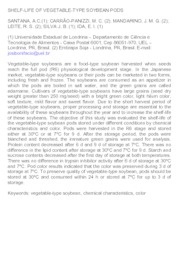Self-life of vegetable-type soybean pods.
Self-life of vegetable-type soybean pods.
Author(s): SANTANA, A. C.; CARRÃO-PANIZZI, M. C.; MANDARINO, J. M. G.; LEITE, R. S.; SILVA, J. B.; IDA, E. I.
Summary: Vegetable-type soybeans are a food-type soybean harvested when seeds reach the full pod (R6) physiological development stage. In the Japanese market, vegetable-type soybeans or their pods can be marketed in two forms, including fresh and frozen. The soybeans are consumed as an appetizer in which the pods are boiled in salt water, and the green grains are called edamame. Cultivars of vegetable-type soybeans have large grains (seed dry weight greater than 250 mg/seed) with a bright green color, light hilum color, soft texture, mild flavor and sweet flavor. Due to the short harvest period of vegetable-type soybeans, proper processing and storage are essential to the availability of these soybeans throughout the year and to increase the shelf-life of these soybeans. The objective of this study was evaluated the shelf-life of the vegetable-type soybean pods stored under different conditions by chemical characteristics and color. Pods were harvested in the R6 stage and stored either at 30ºC or at 7ºC for 9 d. After the storage period, the pods were blanched and threshed, the immature green grains were used for analysis. Protein content decreased after 6 d and 9 d of storage at 7ºC. There was no difference in the lipid content after storage at 30ºC and 7ºC for 9 d. Starch and sucrose contents decreased after the first day of storage at both temperatures. There was no difference in trypsin inhibitor activity after 6 d of storage at 30ºC and 7ºC. Pod color results indicated that the color was preserved during 3 d of storage at 7ºC. To preserve quality of vegetable-type soybean, pods should be stored at 30ºC and consumed within 24 h or stored at 7ºC for up to 3 d of storage.
Publication year: 2011
Types of publication: Abstract in annals or event proceedings
Unit: Embrapa Soybean
Observation
Some of Embrapa's publications are published as ePub files. To read them, use or download one of the following free software options to your computer or mobile device. Android: Google Play Books; IOS: iBooks; Windows and Linux: Calibre.
Access other publications
Access the Agricultural Research Database (BDPA) to consult Embrapa's full library collection and records.
Visit Embrapa Bookstore to purchase books and other publications sold by Embrapa.

